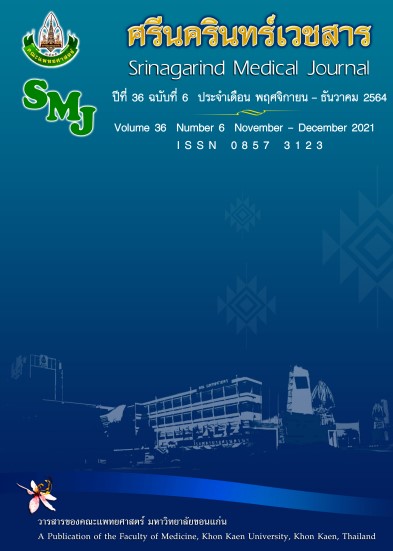Bile Duct Injury Incidence in Patients Undergoing Laparoscopic Cholecystectomy in Srinagarind Hospital, Khon Kaen University, Thailand
Keywords:
Keywords : Laparoscopic surgery; Cholecystectomy; Gall stone; Bile duct injuryAbstract
หลักการและวัตถุประสงค์: การเกิดการบาดเจ็บต่อท่อน้ำดี เป็นภาวะแทรกซ้อนที่ก่อให้เกิดความเสียหาย และส่งผลกระทบต่อผลการรักษาอย่างมาก อุบัติการณ์ ของการเกิดภาวะแทรกซ้อนนี้ค่อนข้างแตกต่างกันไปในแต่ละงานวิจัย จุดประสงค์ของงานวิจัยนี้คือการ ศึกษาเพื่อหาอุบัติการณ์และปัจจัยที่สัมพันธ์กับการเกิดท่อน้ำดีบาดเจ็บหลังการผ่าตัดถุงน้ำดีด้วยการส่องกล้อง
วิธีการศึกษา: เป็นการศึกษาย้อนหลังเชิงพรรณนา ที่จัดทำขึ้นในโรงพยาบาลศรีนครินทร์ ในผู้ป่วยที่ได้รับการผ่าตัดส่องกล้องถุงน้ำดีที่โรงพยาบาลศรีนครินทร์ ตั้งแต่ เดือน มกราคม พ.ศ. 2552 จนถึง เดือน ธันวาคม พ.ศ. 2561โดยศึกษาอุบัติการณ์การบาดเจ็บต่อท่อน้ำดีจากการผ่าตัดดังกล่าว และ ลักษณะของผู้ป่วยที่เกิดการบาดเจ็บนี้
ผลการศึกษา: พบว่าในผู้ป่วย 771 ราย ที่ได้รับการผ่าตัดถุงน้ำดีด้วยวิธีการส่องกล้อง มีผู้ป่วย 11 ราย ที่มีท่อน้ำดีบาดเจ็บ คิดเป็นอุบัติการณ์ร้อยละ 1.43 (95%CI: 0.71 – 2.54) ซึ่งล้วนเป็นผู้ป่วยที่ไม่เคยมีภาวะถุงน้ำดีอักเสบ และไม่มีความผันแปรทางกายวิภาคของท่อทางเดินน้ำดี นอกจากนี้ ยังเป็นผู้ป่วยที่ได้รับการตรวจทางรังสีวิทยาเพียง อัลตราซาวน์ อย่างเดียว โดยการเกิดท่อน้ำดีบาดเจ็บ สัมพันธ์กับการเปลี่ยนวิธีการผ่าตัด จากการส่องกล้องเป็นแบบผ่าเปิด อย่างมีนัยสำคัญทางสถิติ (OR 9.16 (1.85 - 45.46), p = 0.007
ผู้ป่วยที่ได้รับบาดเจ็บท่อน้ำดีต้องพักรักษาในโรงพยาบาลนานขึ้น จากปกติ 4.39 ± 2.73 วัน เป็น 18.82 ± 15.48 วันอย่างมีนัยสำคัญทางสถิติ (p <0.001)
สรุป: จากการศึกษานี้ พบว่ามีผู้ป่วยร้อยละ 1.43 บาดเจ็บท่อน้ำดี ภายหลังการผ่าตัดถุงน้ำดีด้วยวิธีการส่องกล้อง และสัมพันธ์กับการต้องเปลี่ยนวิธีผ่าตัดเป็นแบบเปิด
คำสำคัญ: การผ่าตัดส่องกล้อง; การตัดถุงน้ำดี; นิ่วในถุงน้ำดี; การบาดเจ็บของท่อน้ำดี
Background and Objective: Bile duct injury is a devastating complication following cholecystectomy with significant impact on treatment outcome. The incidence of bile duct injury following laparoscopic cholecystectomy varies between studies. This study aimed to establish the incidence of bile duct injury following laparoscopic cholecystectomy, and factors related to this complication.
Methods: This was a retrospective descriptive study conducted in Srinagarind Hospital, Khon Kaen University, using records of patients who underwent laparoscopic cholecystectomy between January 2552 and December 2561.
Result: In all, 771 patients underwent laparoscopic cholecystectomy. Bile duct injuries were found in 11 patients, giving a cumulative incidence of 1.43% (95%CI: 0.71 – 2.54). All victims had preoperative diagnosis only by ultrasound, had no previous Cholecystitis diagnosis, and had no anatomical variation. Conversion to open surgery was the only variable significantly related to bile duct injury (OR 9.16 (1.85 - 45.46), p = 0.007). Bile duct injury victims needed significantly longer hospitalization than non-victims, 18.82 ± 15.48 days compared to 4.39 ± 2.73 days, (p <0.001).
Conclusion: This study showed incidence of bile duct injury at 1.43% of patients and related to conversion to open surgery during procedure.




